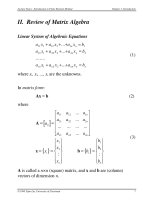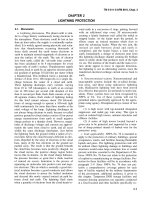CHAPTER 2: CARBONHYDRATE METABOLISM- GLYCOLYTIC ENZYMES ppt
Bạn đang xem bản rút gọn của tài liệu. Xem và tải ngay bản đầy đủ của tài liệu tại đây (5.61 MB, 118 trang )
1
CHAPTER 2: CARBONHYDRATE
METABOLISM- GLYCOLYTIC ENZYMES
INTERNATIONAL UNIVERSITY
SCHOOL OF BIOTECHNOLOGY
BIOCHEMISTRY
2
Learning objectives
1. Review the carbonhydrates
2. Learn the names of the 10 enzymes of glycolysis.
3. Learn the structures of the intermediates in the
glycolytic pathway.
4. Explore the structures of the glycolytic enzymes.
5. Understand the chemical mechanisms of the enzymes
of glycolysis.
3
Brief Content
1.The carbonhydrate
2.The glycolytic enzymes
2.1 Hexokinase
2.2 Phosphoglucose Isomerase
2.3 Phosphofructokinase
2.4 Aldolase
2.5 Triose phosphate Isomerase
2.6 Glyceraldehide-3- phosphate dehydrogenase
2.7 Phosphoglycerate kinase
2.8 Phosphoglycerate mutase
2.9 Enolase
2.10 Pyruvate kinase
4
Detailed Content
1.The carbonhydrate
2.The glycolytic enzymes
2.1 Hexokinase
Structure
Catalytic mechanism
Active site details
2.2 Phosphoglucose Isomerase
Structure
Catalytic mechanism
Active site details
5
Detailed Content
2.3 Phosphofructokinase
Structure
Catalytic mechanism
Active site details
2.4 Aldolase
Structure
Catalytic mechanism
Active site details
6
Detailed Content
2.5 Triose phosphosphate Isomerase
Structure
Catalytic mechanism
Active site details
2.6 Glycealdehide-3- phosphate dehydrogenase
Structure
Catalytic mechanism
Active site details
7
Detailed Content
2.7 Phosphoglycerate kinase
Structure
Catalytic mechanism
Active site details
2.8 Phosphoglycerate mutase
Structure
Catalytic mechanism
Active site details
8
Detailed Content
2.9 Enolase
Structure
Catalytic mechanism
Active site details
2.10 Pyruvate kinase
Structure
Catalytic mechanism
Active site details
9
1 CARBOHYDRATES:
* Sugars, the smallest carbohydrates, serve as
fuel and carbon sources
* Polysaccharides, the polymers of sugars,
have storage and structural roles
Carbohydrates include both sugars and
their polymers. The simplest
carbohydrates are the monosaccharides,
or single sugars, also known as simple
sugars. Disaccharides are double sugars,
consisting of two monosaccharides joined
by condensation. The carbohydrates that
are macromolecules are polysaccharides,
polymers of many sugars.
10
1.1. Sugars, the smallest carbohydrates, serve as fuel and carbon sources
- Monosaccharides (from the Greek monos, single, and sacchar, sugar) generally
have molecular formulas that are some multiple of CH
2
O.
- Glucose (C
6
H
12
O
6
), the most common monosaccharide, is of central importance in
the chemistry of life. In the structure of glucose, we can see the trademarks of a sugar:
- The molecule has a carbonyl group and multiple hydroxyl groups. Depending on the
location of the carbonyl group, a sugar is either an aldose (aldehyde sugar) or a ketose
(ketone sugar).
- Glucose, for example, is an aldose; fructose, a structural isomer of glucose, is a
ketose. (Most names for sugars end in -ose. )
- Monosaccharides, particularly glucose, are major nutrients for cells. In the process
known as cellular respiration, cells extract the energy stored in glucose molecules.
- Not only are simple sugar molecules a major fuel for cellular work, but their carbon
skeletons serve as raw material for the synthesis of other types of small organic
molecules, such as amino acids and fatty acids.
- Sugar molecules that are not immediately used in these ways are generally
incorporated as monomers into disaccharides or polysaccharides.
11
Fig 3.1. The structure and classification of some monosaccharides.
Sugars may be aldoses (aldehyde sugars) or ketoses (ketone sugars), depending on the location of
the carbonyl group (pink). Sugars are also classified according to the length of their carbon
skeletons. A third point of variation is the spatial arrangement around asymmetric carbons
(compare, for example, the gray portions of glucose and galactose).
12
Fig 3.2. Linear and ring forms of glucose
13
- A disaccharide consists of two monosaccharides joined by a
glycosidic linkage, a covalent bond formed between two
monosaccharides by a dehydration reaction. For example, maltose is a
disaccharide formed by the linking of two molecules of glucose.
- Also known as malt sugar, maltose is an ingredient for brewing beer.
The most prevalent disaccharide is sucrose, which is table sugar. Its
two monomers are glucose and fructose.
- Plants generally transport carbohydrates from leaves to roots and
other nonphotosynthetic organs in the form of sucrose.
- Lactose, the sugar present in milk, is another disaccharide, consisting
of a glucose molecule joined to a galactose molecule.
14
Fig 3.3.
Examples
of
disaccharide
synthesis
15
1.2 Polysaccharides, the polymers of sugars,
have storage and structural roles
- Polysaccharides are macromolecules, polymers with a
few hundred to a few thousand monosaccharides joined
by glycosidic linkages.
- Some polysaccharides serve as storage material,
hydrolyzed as needed to provide sugar for cells.
- Other polysaccharides serve as building material for
structures that protect the cell or the whole organism.
- The architecture and function of a polysaccharide are
determined by its sugar monomers and by the positions of
its glycosidic linkages.
16
- Starch, a storage polysaccharide of plants, is a polymer consisting entirely of
glucose monomers. Most of these monomers are joined by 1-4 linkages (number 1
carbon to number 4 carbon), like the glucose units in maltose. The angle of these
bonds makes the polymer helical.
- The simplest form of starch, amylose, is unbranched. Amylopectin, a more
complex form of starch, is a branched polymer with 1-6 linkages at the branch
points.
- Plants store starch as granules within cellular structures called plastids, including
chloroplasts (see fig5-6a). By synthesizing starch, the plant can stockpile surplus
glucose. Because glucose is a major cellular fuel, starch represents stored energy.
The sugar can later be withdrawn from this carbohydrate bank by hydrolysis,
which breaks the bonds between the glucose monomers.
- Animals store a polysaccharide called glycogen, a polymer of glucose that is like
amylopectin but more extensively branched. Humans and other vertebrates store
glycogen mainly in liver and muscle cells. Hydrolysis of glycogen in these cells
releases glucose when the demand for sugar increases.
1.2.1 Storage polysaccharides
17
Fig 3.4. Storage polysaccharides.
These examples, starch and glycogen, are composed entirely of glucose monomers,
abbreviated here as hexagons. The polymer chains tend to spiral to form helices.
18
- Organisms build strong materials from structural polysaccharides. For
example, the polysaccharide called cellulose is a major component of the
tough walls that enclose plant cells. On a global scale, plants produce almost
1011 (100 billion) tons of cellulose per year; it is the most abundant organic
compound on Earth.
- Like starch, cellulose is a polymer of glucose, but the glycosidic linkages in
these two polymers differ. The difference is based on the fact that there are
actually two slightly different ring structures for glucose.
- When glucose forms a ring, the hydroxyl group attached to the number 1
carbon is locked into one of two alternative positions: either below or above
the plane of the ring. These two ring forms for glucose are called alpha (a) and
beta (b), respectively.
- In starch, all the glucose monomers are in the a configuration.
- In contrast, the glucose monomers of cellulose are all in the b configuration,
making every other glucose monomer upside down with respect to the others.
1.2.2. Structural polysaccharides
19
Fig 3.5.
Starch and
cellulose
structures
20
- The differing glycosidic links in starch and cellulose give the two
molecules distinct three-dimensional shapes. Whereas a starch
molecule is mostly helical, a cellulose molecule is straight (and never
branched), and its hydroxyl groups are free to hydrogen-bond with the
hydroxyls of other cellulose molecules lying parallel to it.
- In plant cell walls, parallel cellulose molecules held together in this
way are grouped into units called microfibrils. These cables are a
strong building material for plants as well as for humans, who use
wood, which is rich in cellulose, for lumber.
- Enzymes that digest starch by hydrolyzing its a linkages are unable
to hydrolyze the b linkages of cellulose. In fact, few organisms
possess enzymes that can digest cellulose. Humans do not; the
cellulose fibrils in our food pass through the digestive tract and are
eliminated with the feces.
21
Some microbes can digest cellulose, breaking it down to
glucose monomers. Another important structural
polysaccharide is chitin, the carbohydrate used by arthropods
(insects, spiders, crustaceans, and related animals) to build
their exoskeletons. An exoskeleton is a hard case that
surrounds the soft parts of an animal. Pure chitin is leathery,
but it becomes hardened when encrusted with calcium
carbonate, a salt.
-
Chitin is also found in many fungi, which use this
polysaccharide rather than cellulose as the building material for
their cell walls.
- Chitin is similar to cellulose, except that the glucose monomer of
chitin has a nitrogen-containing appendage:
22
Fig 3.6. The arrangement of cellulose in plant cell walls.
23
Fig 3.7. Chitin, a structural polysaccharide.
(a) Chitin forms the exoskeleton of arthropods. This
cicada is molting, shedding its old exoskeleton and
emerging in adult form.
(b) Chitin is used to make a strong and flexible
surgical thread that decomposes after the wound
or incision heals
24
- The molecule known as ATP, short for adenosine triphosphate, is the central character
in bioenergetics
- The triphosphate tail of ATP is the chemical equivalent of a loaded spring; the close
packing of the three negatively charged phosphate groups is an unstable, energy-storing
arrangement. The chemical "spring" tends to "relax" by losing the terminal phosphate
- The cell taps this energy source by using enzymes to transfer phosphate groups from
ATP to other compounds, which are then said to be phosphorylated. Phosphorylation
primes a molecule to undergo some kind of change that performs work, and the molecule
loses its phosphate group in the process
ATP = ADP + Pi
- For example, a working muscle cell, for example, recycles its ATP at a rate of about 10
million molecules per second. To understand how cellular respiration regenerates ATP,
we need to examine the fundamental chemical processes known as oxidation and
reduction.
THE STRUCTURE OF ATP, NAD+
25
Fig 3.8. The
structure and
hydrolysis of ATP.
The hydrolysis of ATP
yields inorganic
phosphate and ADP.
In the cell, most
hydroxyl groups of
phosphates are
ionized ( O-).









